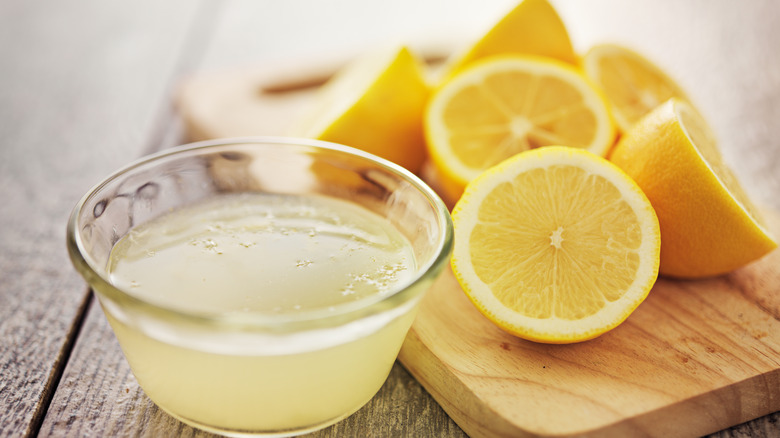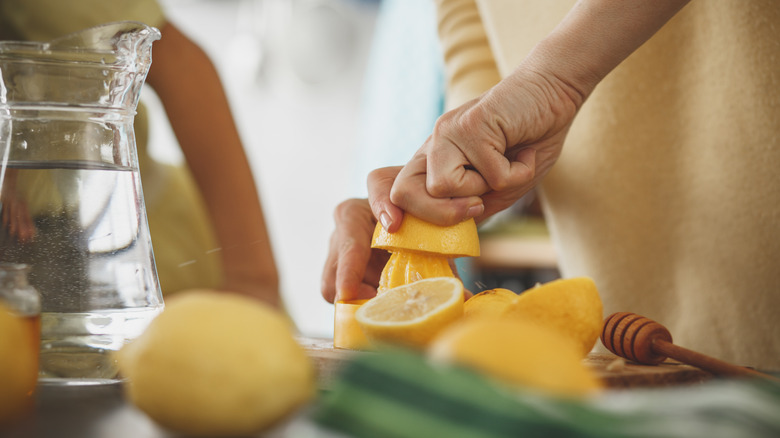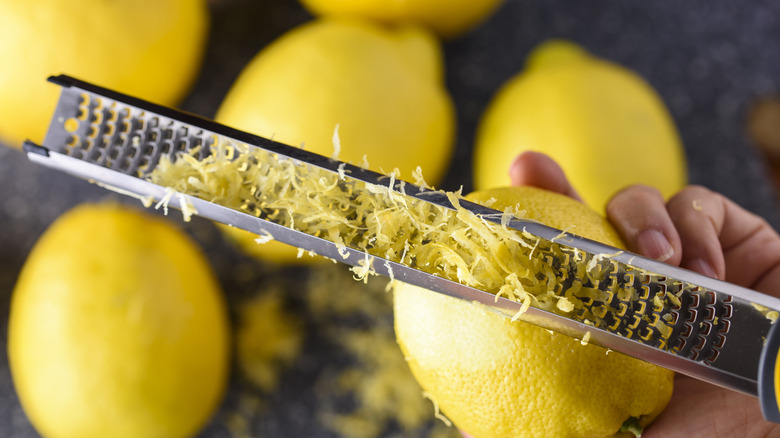How Much Juice Is Usually In One Lemon?
One of the easiest ways to brighten up the flavor of a recipe is to add a little bit of lemon juice. This is why you'll see it pop up on ingredient lists for dishes like brothy soups and creamy pastas. While you can buy pre-squeezed, shelf-stable lemon juice at the grocery store, unless you have a reason to use a cup or more of the sour stuff it just doesn't make sense to keep it around when you can simply squeeze a lemon or two to get fresher, tastier juice. It's also easy to figure out how many lemons you need because one lemon contains around two to three tablespoons of juice depending on the size of the lemon and the thickness of the rind.
Most recipes that call for lemon juice (apart from actual juice recipes or to use for cleaning) tend to call for tablespoons or teaspoons because a little lemon goes a long way. So when you're in the grocery store shopping for ingredients, all you have to do is grab one lemon for every two tablespoons of juice required or think of each half of a lemon as one tablespoon. The real trick is to juice a lemon properly so that you get every last drop.
Squeezing the juice
The key to getting the full two or three tablespoons of juice out of a fresh lemon is to properly squeeze it. There are a couple of ways you can approach juicing a lemon, but above all, do not try to simply squeeze the fruit with your hands. Lemons can be very dense, and their juice is carefully packed inside hundreds of natural sacs called vesicles. In order to get all the juice out of a lemon you have to break open as many vesicles as possible, which is why you'll need to use some sort of tool to juice the fruit since your hands alone can't do the job.
The two most popular tools for juicing a lemon are a reamer and a juice press. There are many different models of both tools, including handheld and countertop versions. The main difference between the two tools is that reamers have a pointy, ridged shape that you plunge into a cut lemon to break up all the pulp and release the juice. Presses, as the name suggests, squish or flatten the fruit to push out all the juice. Both tools are very effective, so it's up to you as a chef to choose what works best for you. If you don't have either tool, a large kitchen spoon also works well as a reamer, or you can even break out the kitchen shears.
Don't forget the zest
If you're keeping track of the juice volume for a recipe (as opposed to measuring with your heart), squeeze it all into a small bowl and then measure out the teaspoons or tablespoons from there. This will prevent you from getting any bitter lemon seeds mixed up in whatever food you're making. This step will also give you a precise amount of juice because even though most lemons have roughly the same volume of liquid, there's no way to know if there are two or three tablespoons without actually doing the measuring. For many recipes, there's a big difference if you add an extra tablespoon of lemon juice, or conversely not enough, so it's a good practice to measure your juice even if you have an idea of what a tablespoon looks like.
Oftentimes a recipe that calls for lemon juice will also call for lemon zest. If this is the case, make sure you scrape the zest off of your lemons with a citrus zester or microplane before you squeeze them, because it's much harder to zest a lemon that's already been squeezed. Each lemon will yield about a tablespoon of zest, so factor that in that rule of thumb, too, the next time you're shopping for lemons.


